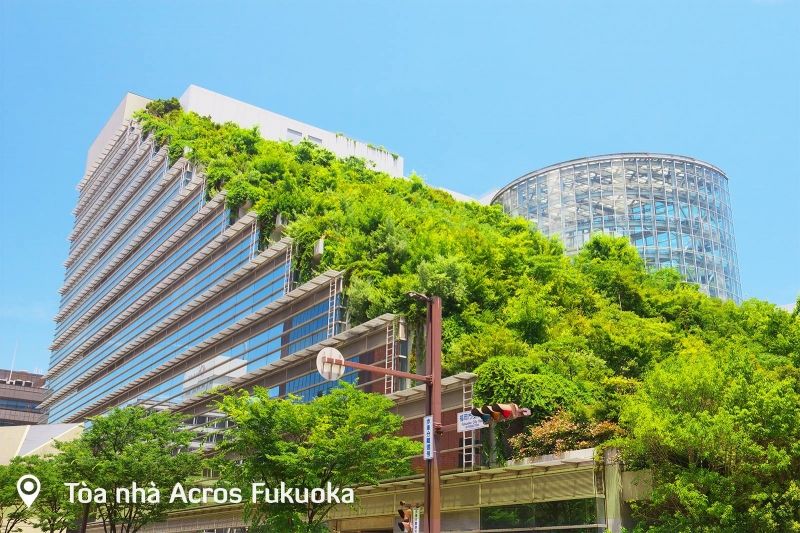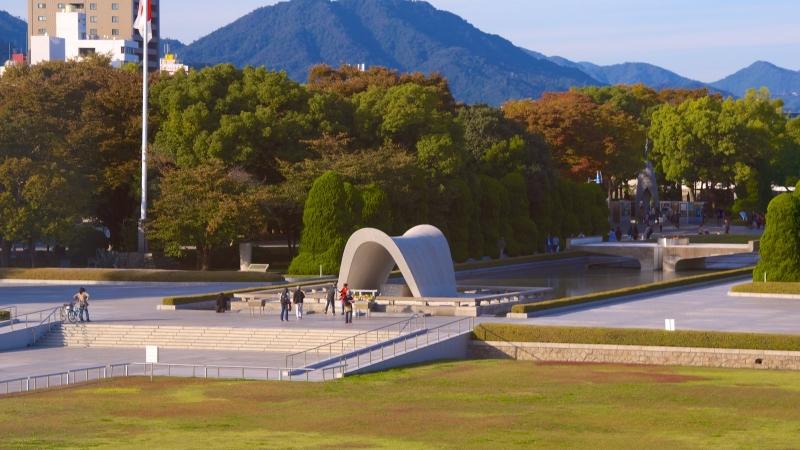Top of the most famous architectural works in Japan #3
Not only famous for its beautiful natural scenery and unique long-standing culture, the land of cherry blossoms is also a place with unique architectural works, a convergence of artistic and intellectual quintessence. Japanese wisdom. In this topic of discovery, let's join Toplist.vn to learn about famous architectural works in Nhat Ban. We are sure that you will feel interested in this magical country.
Acros Building
Located right in the center of Fukuoka city, Japan, the Acros building has a bold style of green architecture, blending with nature, and is an attractive and prominent place on a trip to visit the peaceful city. This. With the goal of creating a building that is in harmony with the surrounding parks and contributes to maintaining green spaces for the city, architect Emilio Ambasz and his colleagues created a unique masterpiece inspired by of the pyramids combined with the greening of the building's exterior
The overall architecture of the building consists of two separate parts: one part is for office activities with walls made entirely of glass, and the remaining part (accounting for 3/4 of the area) is a large sloping roof. Covered with 50,000 varieties of trees of diverse types, shaped like a "terraced field" 60 m high. In particular, with a view from above, the whole building seems to completely disappear and is replaced by the image of "a hill" with lush green vegetation in the middle of a busy urban area.
Currently, this amazing Acros building is still being used as a normal office building and is also a scenic spot loved by many tourists when visiting Fukuoka..
Hiroshima Memorial Site
The Hiroshima Peace Memorial Park (広島平和記念碑 Hiroshima Heiwa Kinenhi?) was originally the Hiroshima Prefectural Trade Show, and is now commonly known as the Atomic Bomb Dome or A-Bomb Dome (原爆ドーム Genbaku Dōmu?) is part of the Hiroshima Peace Memorial Park located in Hiroshima, Japan. Declared a UNESCO World Heritage Site since 1996, it is a memorial to those who died in the Atomic Bombing of Hiroshima on August 6, 1945. More than 70,000 died and Another 70,000 people were seriously injured due to the effects of radiation.
This was originally the Hiroshima Prefectural Trade Exhibition Hall designed by Czech architect Jan Letzel. The design includes a special dome at the highest position of the building. The work was completed in April 1915 and was named the Hiroshima Prefectural Trade Exhibition (HMI).
The building officially opened to the public in August of the same year. By 1921, it was renamed Hiroshima Prefectural Products Display Hall and renamed again in 1933 to Hiroshima Prefectural Industrial Promotion Hall. This structure is located in a large commercial area next to Aioi Bridge and is mainly used for art and educational exhibitions.
Himeji Castle, Hyogo
Himeji Castle is located in the center of Himeji city, 650 km west of Tokyo. This is a prime example of traditional Japanese castle architecture. This work was recognized by UNESCO as a world heritage site in 1993 and is a special historical site of Japan. The castle's walls are made of wood and covered with a layer of white plaster to prevent fire. Therefore, Himeji is also called "White Crane Castle".
The castle complex includes a network of 83 buildings such as warehouses, gates, corridors and turrets (yagura). Of these 83 buildings, 74 are designated as Important Cultural Properties: 11 corridors, 16 turrets, 15 gates and 32 earthen walls. The tallest walls in the castle complex are 26 m high. Joining the castle complex is Koko-en Garden, a Japanese garden was created in 1992 to commemorate the 100th anniversary of Himeji city.
Himeji Castle began to be built in 1333 by order of lord Norimura Akamatsu of Harima region. Initially it was just a defensive fortress. In 1346, Norimura's son, Sadanori, built additional residences and other outbuildings. Afterwards, the warlords Kotera and Kuroda took control of the region. Some researchers believe that the main castle was built in the mid-16th century, when Shigetaka Kuroda and his son Mototaka Kuroda held power in the region. When Kanbei Shigetaka Kuroda controlled this area, Hideyoshi Hashiba came to this castle to build his own three-story castle. Later Hideyoshi Hashiba and later Iesada Kinoshita succeeded in controlling the castle. After the Sekigahara civil war, lord Terumasa Ikeda - adopted son of Shogun Ieyasu Tokugawa came to this castle to run it.
The wonderful White Crane Castle that everyone sees today was completely completed in 1618. After the time of the Honda family, there were other lords such as the Matsudaira family and the Sakakibara family. Tadazumi Sakai finally took over as lord in 1749. His descendants participated in the Meiji Reform of 1868, when the Shogun era ended.
Itsukushima Shrine
Itsukushima-jinja Shrine is a complex of many temples built in the 12th century by Taira no Kiyomori - a very powerful man at that time. It is known for its beautiful architecture and basic framework created in the Shinden-zukuri style (architecture often used when building residences for nobles) of the Heian period (794–1185), has an extremely creative and adventurous layout when built on the sea. At high tide, you can see the red temple with its long corridors floating on the sea surface.
This temple was built based on the ideas of Taira no Kiyomori, boasting a rare beauty, harmoniously coordinated with the mountains behind and the Setouchi sea. The Itsukushima-jinja shrine complex worships nature deities such as the mountain god, and also follows the usual temple architecture of placing the "Yohaijo" shrine at the foot of the mountain. The view of the Itsukushima-jinja temple architectural complex blends and merges with nature and the surrounding environment, creating a unique and beautiful work of art in Japan, making it an important cultural asset. transform the spirit of the Japanese people.
From Miyajimaguchi, take the ferry to Miyajima ferry terminal, you will arrive at the foot of the famous mountain, considered the symbol of Miyajima island. There is a walking path leading to Itsukushima-jinja Shrine. On both sides of the road there are many shops selling local products, so visitors can freely explore. This place is famous for Momiji-manju dumplings and Shamoji ladles.






































